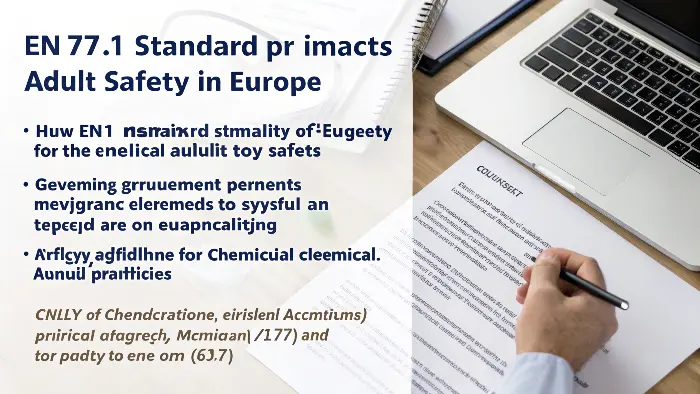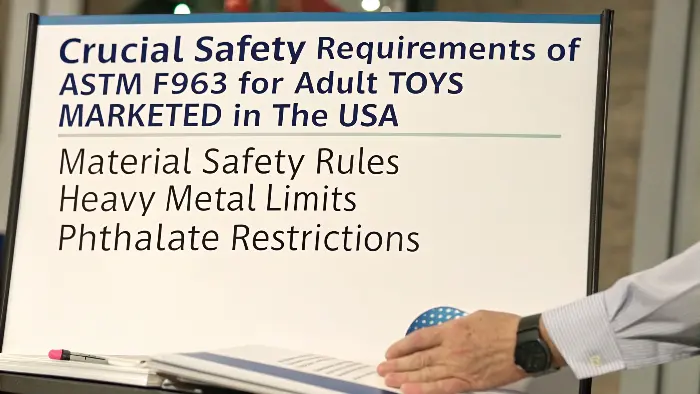Worried if your adult toys are truly safe? Hidden nasties in materials are a genuine fear for users and a headache for brands. Understanding safety testing isn’t just smart; it’s essential.
Material safety testing for adult toys evaluates harmful substances, mechanical durability, and electrical safety if applicable, often guided by ISO 10993 for biocompatibility. This ensures products are safe for intimate contact, free from harmful chemicals, and meet relevant safety benchmarks before they reach your customers.
When we talk about adult toys, safety isn’t just a buzzword; it’s the bedrock of trust between a brand like PrivyPlay and our customers. People are placing these products on and in their most intimate areas! So, as brand owners or sourcing managers, we have a massive responsibility. I remember when we were first developing a new line; the sheer number of standards and tests felt overwhelming. But diving deep into what’s required, and even what’s best practice, became a non-negotiable part of our process. It’s not just about avoiding recalls; it’s about genuinely caring for our customers’ well-being. So, let’s unpack what goes into making sure these products are as safe as they are pleasurable.
What Are the Key International Standards Guiding Adult Toy Safety Testing?
Navigating global safety rules for adult toys can feel like a maze. Non-compliance isn’t just risky; it can tank your brand and, worse, harm users. Luckily, key standards offer a clearer path.
While no single global standard exists exclusively for adult toys, ISO 10993 (Biocompatibility) is critical. General toy safety standards like Europe’s EN 71 and the USA’s ASTM F963 are also often referenced for mechanical and chemical safety, guiding best practices.
So, you’re looking for the international standard for adult toys? Well, it’s a bit more nuanced than that. There isn’t one single, universally adopted law or standard specifically labelled "for adult toys." Instead, we in the industry look to a combination of standards, drawing from those that govern similar product categories, especially medical devices and children’s toys, because they deal with items that have close bodily contact or stringent chemical requirements.
The big one I always emphasize for intimate products is ISO 10993: Biological evaluation of medical devices. This is a whole series of standards! It covers things like:
- Cytotoxicity (Part 5): Are the materials toxic to cells?
- Irritation and skin sensitization (Part 10 & Part 23): Will it cause rashes or allergic reactions?
-
Systemic toxicity (Part 11): Any harmful effects if substances leach into the body?
For products that PrivyPlay develops, especially those with prolonged or internal contact, we lean heavily on ISO 10993 principles. It’s just good sense.
Then you have chemical regulations like REACH (Registration, Evaluation, Authorisation and Restriction of Chemicals) in Europe. This is massive! It restricts a long list of harmful substances (SVHCs – Substances of Very High Concern) in all consumer products, including adult toys. Things like certain phthalates, heavy metals, and problematic flame retardants are covered. We always check our material Bill of Substances against REACH.
For electrical toys, RoHS (Restriction of Hazardous Substances) is key, limiting lead, mercury, cadmium, etc., in electrical and electronic equipment.
It’s a patchwork, yes, but a responsible brand pieces these together to build a comprehensive safety profile. It’s not just about ticking boxes; it’s about a commitment to safety. We’ve walked away from suppliers whose materials couldn’t meet these benchmarks – it’s that important.Standard/Regulation Primary Focus Relevance to Adult Toys ISO 10993 Biocompatibility of medical devices Essential for intimate contact: cytotoxicity, irritation, sensitization testing. REACH (EU) Chemical safety, restriction of harmful substances Crucial for all materials: limits phthalates, PAHs, heavy metals, etc. RoHS (EU & other regions) Restriction of hazardous substances in EEE Applies to vibrators and other electronic toys: limits lead, mercury, cadmium. EN 71 (EU) Safety of (children’s) toys Parts on chemical migration (EN 71-3) and physical properties are often referenced. ASTM F963 (US) Safety of (children’s) toys Similar to EN 71, its chemical limits (heavy metals, phthalates via CPSC) are important. It’s about due diligence, plain and simple.
How Does the EN 71 Standard Specifically Impact Adult Toy Safety in Europe?
Selling in Europe? EN 71 looms large, but its application to adult toys can be fuzzy. Misunderstanding its parts can block market access or bring penalties. Let’s clarify its role.
EN 71, the European toy safety standard, impacts adult toys mainly via its chemical requirements (EN 71-3: migration of elements) and sometimes its mechanical/physical property guidelines (EN 71-1). Though not designed for adult toys, its safety principles are frequently applied.
 Dive deeper Paragraph: Ah, EN 71 – the famous European standard for toy safety. Now, technically, adult toys aren’t "toys" in the eyes of EN 71, which is aimed at products designed or intended for use in play by children under 14 years of age. However! And this is a big "however" – its principles, especially around material safety, are often used as a benchmark by authorities and by responsible manufacturers like us at PrivyPlay, especially when there’s no other specific regulation to point to. The most relevant part for us is EN 71-3: Migration of certain elements. This part sets strict limits on how much of 19 different heavy metals (like lead, cadmium, mercury, arsenic, chromium, etc.) can leach out of a material if a child were to, say, suck or chew on it. The logic for adult toys is similar: if these materials are in prolonged intimate contact with mucous membranes, we absolutely don’t want harmful metals migrating into the body. So, ensuring our silicones, TPEs, or any other material meets EN 71-3 limits is a baseline for us. I’ve seen test reports, and getting a pass on this is non-negotiable. Then there’s EN 71-1: Mechanical and physical properties. While some parts are clearly for children’s toys (like not having small parts that are choking hazards for under-3s), the general principles of good construction, no sharp edges, no sharp points, and structural integrity are still good practice for adult toys. You don’t want something breaking during use or having a rough finish that could cause injury. EN 71-9: Organic chemical compounds is another one, though often REACH is more comprehensive for adult products concerning things like phthalates or flame retardants. But it’s good to be aware of. The bottom line is, while your adult toy might not legally be an EN 71 toy, demonstrating that your materials would pass key EN 71 tests, particularly EN 71-3, shows a strong commitment to safety for the European market. It’s about anticipating what a discerning customer (or a cautious regulator) might expect. We’ve had discussions with testing labs specifically about which parts of EN 71 make sense to apply, and EN 71-3 always comes up. It’s just good manufacturing practice. |
EN 71 Part | Description | Relevance to Adult Toys |
|---|---|---|---|
| EN 71-1 | Mechanical & Physical Properties | Good practice for structural integrity, avoiding sharp edges/points. | |
| EN 71-3 | Migration of Certain Elements (Heavy Metals) | Highly relevant: ensures low levels of leachable toxic metals from materials. A must-do! | |
| EN 71-9 | Organic Chemical Compounds (e.g., some phthalates, flame retardants, primary aromatic amines) | Good awareness, though REACH often more stringent/broader for adult products for these. |
It helps build a solid safety case for your products.
What Are the Crucial Safety Requirements of ASTM F963 for Adult Toys Marketed in the USA?
Targeting the US? ASTM F963 is the standard for toys, but how does it translate to adult products? Ignoring these safety specs can mean import woes or serious liability issues.
ASTM F963, the US toy safety standard, is legally mandated for children’s toys. For adult toys, its material safety rules (like heavy metal limits, similar to EN 71-3, and phthalate restrictions via CPSC) are vital best practices for ensuring chemical safety.
 Dive deeper Paragraph: Over in the USA, the main toy safety standard you’ll hear about is ASTM F963: Standard Consumer Safety Specification for Toy Safety. Just like EN 71 in Europe, this is legally mandated for children’s toys (thanks to the Consumer Product Safety Improvement Act – CPSIA). And again, while adult toys aren’t "children’s toys," key parts of ASTM F963, especially those concerning material safety, are absolutely what we look at for products heading to the US market. The Consumer Product Safety Commission (CPSC) oversees product safety in general, and they can take action against any unsafe consumer product. A critical section for us is Section 4.3.5: Heavy Metals. This specifies limits for the same types of heavy metals as EN 71-3 (lead, cadmium, mercury, etc.) in toy materials that could be ingested. The testing methods are slightly different, but the goal is the same: keep these toxic metals out! We ensure our materials destined for the US market meet these ASTM F963 requirements. It’s a fundamental safety check. Then there are phthalates. While ASTM F963 references them, the actual restrictions for certain phthalates (like DEHP, DBP, BBP, DINP, DIDP, DnOP) in children’s toys and child care articles come directly from the CPSC under CPSIA. Given the intimate nature of adult toys, these phthalate restrictions are super relevant. Many of these are known endocrine disruptors, and you definitely don’t want them in your products. PrivyPlay is strictly phthalate-free, period. It’s a promise we make. Mechanical aspects like Section 4.7 (Accessible Edges) and Section 4.9 (Accessible Points) are also good guidelines. No one wants a product with dangerously sharp bits, regardless of age. So, while an adult toy might not need formal ASTM F963 certification as a "child’s toy," complying with its relevant chemical and physical safety provisions is a smart move. It shows due diligence and helps protect your brand and your customers. I recall a particular supplier discussion where we insisted on seeing test reports for ASTM F963 heavy metals before we’d even consider their material for a US product. They were surprised at our strictness for an "adult" item, but for us, it’s just standard procedure. Your reputation depends on it! 🔥 |
ASTM F963 Section / CPSC Rule | Description | Relevance to Adult Toys |
|---|---|---|---|
| Section 4.3.5 | Heavy Metals in Substrate Materials | Essential: Limits soluble heavy metals in materials, critical for intimate contact. | |
| CPSC Phthalate Rules (CPSIA) | Restrictions on specific phthalates | Extremely relevant: Many phthalates are banned/restricted; adult toys should be phthalate-free. | |
| Section 4.7 | Accessible Edges | Good practice: Ensures no hazardous sharp edges that could cause injury. | |
| Section 4.9 | Accessible Points | Good practice: Ensures no hazardous sharp points that could cause injury. |
These aren’t just suggestions; they are critical safety benchmarks in my book.
Conclusion
Material safety is paramount. Adhering to testing protocols and standards like ISO 10993, plus key EN 71 and ASTM F963 principles, ensures adult toy safety, builds trust, and protects your brand.
